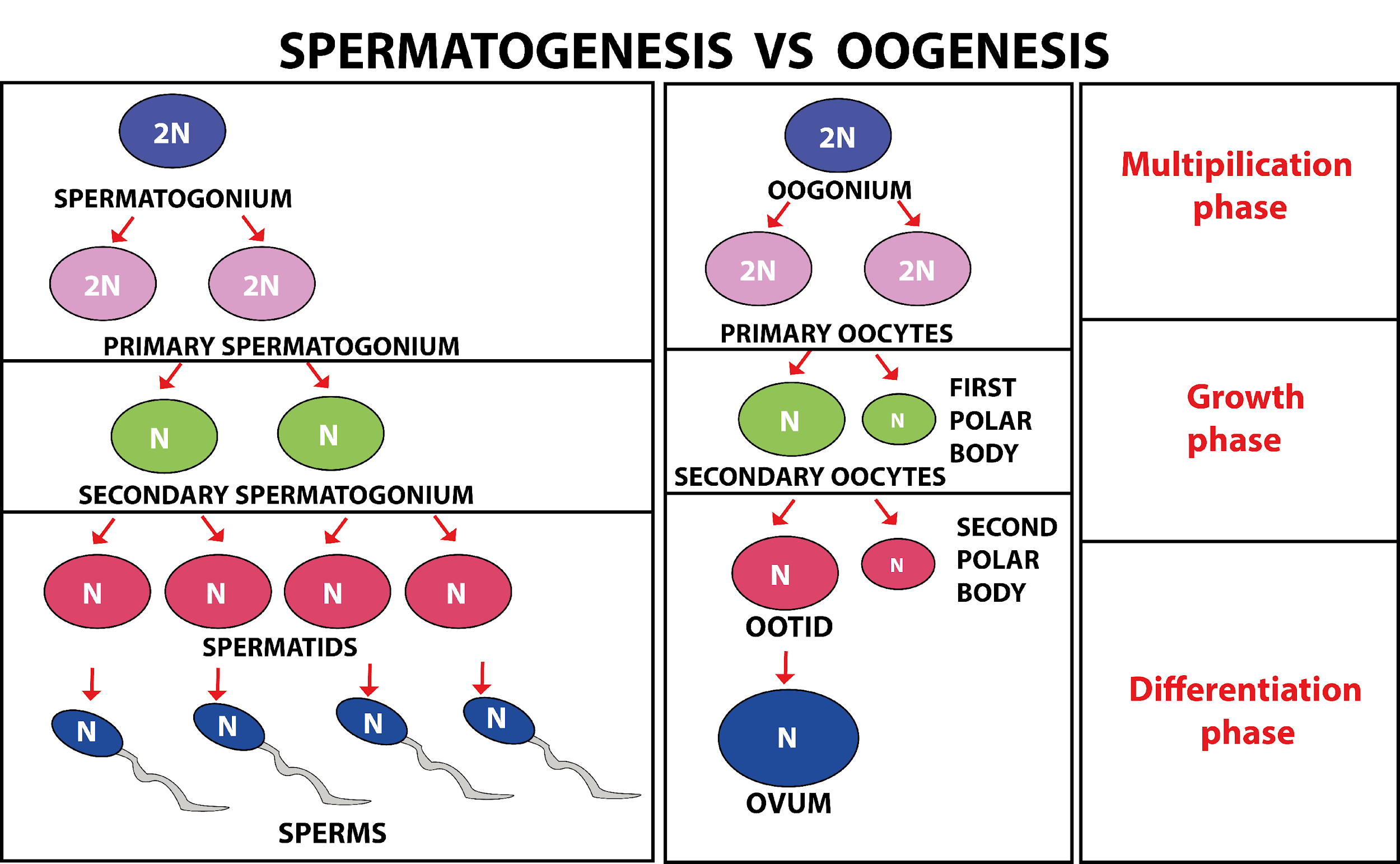
Write four differences between Spermatogenesis and Oogenesis.
Answer
571.5k+ views
Hint: Spermatogenesis and oogenesis are the processes of the formation of male and female gametes. Spermatogenesis leads to the formation of sperms, whereas, oogenesis helps in the formation of ova. The fertilization of sperm and ova leads to the formation of a zygote which further develops into an embryo.
Complete answer:
Difference between Spermatogenesis and Oogenesis
Additional Information: -Spermatogenesis and oogenesis are the reproductive phases that include three phases – multiplication, growth, maturation, and differentiation.
- The spermatogonium and oogonium multiply by mitosis to form spermatocytes and oocytes. The spermatocytes and oocytes (germ cells) undergo meiosis and maturation to form spermatids and ootids that further differentiate to form sperms and ovum.
- Spermatogenesis occurs inside the seminiferous tubules in the testis. The entire process takes about 70 days.
- Sperms can be stored and maintain fertility in genital ducts for as long as 42 days.
Ovum is enclosed by two additional coats/protective layers – Zona pellucida and Corona Radiata.
Note: The human female is born with a million egg cells in her ovary. These cells start maturing during puberty. No more egg cells are formed in the female body after birth.
- A woman's reproductive life generally ends at menopause, due to exhaustion of ovarian follicles which occurs at the age of 50s.
- A man's reproductive life never ends, unless disability or disease renders him unable to produce sperms.
- Sometimes more than one secondary oocyte is released. This is the commonest cause of multiple births. In such cases, the twins are called fraternal twins.

Complete answer:
Difference between Spermatogenesis and Oogenesis
| Spermatogenesis | Oogenesis |
| The production of sperms from spermatogonia is known as spermatogenesis. | The production of eggs from oogonia is known as oogenesis. |
| Occurs in testes. | Occurs inside the ovary. |
| All stages are completed in the testis. | The major part of oogenesis occurs inside the ovary. The last few stages occur in the oviduct. |
| Produces motile gametes | Produces non-motile gametes |
| Four sperms are formed by the equal cytokinesis that occurs during spermatogenesis. | One ovum and four polar bodies are produced by unequal cytokinesis occurring during oogenesis. |
| Millions of sperms are produced every day. | One ovum is released per month. |
| Very little food reservation in sperms | Large amounts of food and metabolite are stored in the ovum. |
Additional Information: -Spermatogenesis and oogenesis are the reproductive phases that include three phases – multiplication, growth, maturation, and differentiation.
- The spermatogonium and oogonium multiply by mitosis to form spermatocytes and oocytes. The spermatocytes and oocytes (germ cells) undergo meiosis and maturation to form spermatids and ootids that further differentiate to form sperms and ovum.
- Spermatogenesis occurs inside the seminiferous tubules in the testis. The entire process takes about 70 days.
- Sperms can be stored and maintain fertility in genital ducts for as long as 42 days.
Ovum is enclosed by two additional coats/protective layers – Zona pellucida and Corona Radiata.
Note: The human female is born with a million egg cells in her ovary. These cells start maturing during puberty. No more egg cells are formed in the female body after birth.
- A woman's reproductive life generally ends at menopause, due to exhaustion of ovarian follicles which occurs at the age of 50s.
- A man's reproductive life never ends, unless disability or disease renders him unable to produce sperms.
- Sometimes more than one secondary oocyte is released. This is the commonest cause of multiple births. In such cases, the twins are called fraternal twins.

Recently Updated Pages
Master Class 12 Business Studies: Engaging Questions & Answers for Success

Master Class 12 Economics: Engaging Questions & Answers for Success

Master Class 12 English: Engaging Questions & Answers for Success

Master Class 12 Maths: Engaging Questions & Answers for Success

Master Class 12 Social Science: Engaging Questions & Answers for Success

Master Class 12 Chemistry: Engaging Questions & Answers for Success

Trending doubts
What are the major means of transport Explain each class 12 social science CBSE

Which are the Top 10 Largest Countries of the World?

Draw a labelled sketch of the human eye class 12 physics CBSE

How much time does it take to bleed after eating p class 12 biology CBSE

Explain sex determination in humans with line diag class 12 biology CBSE

Differentiate between homogeneous and heterogeneous class 12 chemistry CBSE




